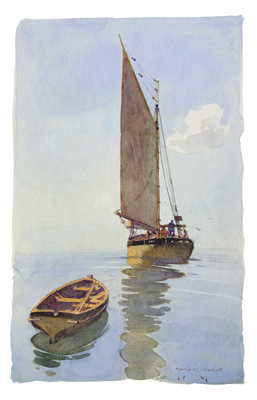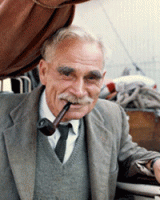Running aground in a yacht is never a pleasant experience. To do so off a remote island in the Svalbard archipelago surrounded by icebergs, as Bill Tilman did, can easily be catastrophic.
Bill Tilman: ‘We might well become a shipwreck if a piece of ice with Baroque’s name on it hit her in a vital spot’
The breeze having died we were again under engine when at 0400 I took over the watch from Alan. What followed is not easy to explain and still less easy to excuse. Perhaps, having spent the last three days mostly on deck and enjoyed only disturbed nights, I was not as bright as I should have been. Zeiloyane, the two islets mentioned above, were in sight ahead and with the west-going ebb under us we were rapidly approaching them, We had already discovered that west of Cape Heuglin along the north coast of Edge Island the water was shoal and we intended passing north of the Zeiloyane islets. I had my eyes fixed on one but the northernmost looked to me like a spit of land projecting from the coast of Barents Island. What with the engine and the tide, which as we neared the islets seemed to gather speed for its rush through the channel, we must have been making 7 or 8 knots over the ground. Before I had really hoisted in what was happening we were heading between the two islets, which are a mile or so apart. To attempt to pass between unknown islets, however wide apart, is always a hazardous proceeding. A shoal extended the whole way between the two and the rate we were going ensured our being carried right up the back of it before we ground to a stop.
If the crew thought the old man had taken leave of his senses, as they must have done, they studiously refrained from comment. As soon as the tide slackened a bit we ran out a kedge astern, bringing the warp forwards to the winch. The engine, as we knew, had no power in reverse and the winch alone failed to budge her.
Circumstances had combined to make things as difficult as they could be. Although the ebb had been running for an hour or more we must have gone on at or near the highest level of water; it was three days after full moon so that the tides were taking off. The differences between high and low water proved to be only around 2ft, which was a good thing because the boat remained more or less upright.
Our next move was to take out half the ballast and jettison it over the side. We had no choice. The nearest islet was half a mile away and in the absence of any appreciable slack water there was no question of rowing a heavily-laden dinghy that far. In spite of a strong westerly wind blowing out of the strait – a wind that blew incessantly for the next few days – the sea remained calm and the boat motionless. There was thus no fear of the boat damaging herself by pounding, but we had something else to worry about. When the west-going stream started again it brought with it numerous ice-floes, large and small. The big ones grounded on the edge of the shoal about fifty yards away where they furnished a kind of protective barrier. There were, however, gaps in the barrier through which any piece of ice that drew less than 6ft or 7ft of water found its way, and by driving past the boat at a rate of several knots threatened disaster to either our rudder or our propeller. Bits of ice moving at that rate, even if they weighed only half a ton or so, could neither be stopped nor diverted with boathooks. Watching a small floe apparently on a collision course we could only hold our breath and hope. Twice the rudder sustained a savage blow. Nor were we much better off when the tide turned, when those that had already passed came back with the flood.
No one doubted that we should get her off in time – at least no doubts were expressed – but I felt that we had only to stay there long enough for the worst to happen. Damage to the rudder would be bad enough but if the propeller were damaged the chances of getting off would be much reduced; for by now it was clear that we must get her facing the way she had come so that the engine could be used to advantage. We were a sitting target for those floes, dependent entirely upon luck.
In the afternoon, near high water, we made several attempts to pull her head round, for until we could get her pointing the way she had come and so make full use of the engine we should never get off. Having got us into this mess I at least should have skilly for supper, instead we finished up with one of David’s increasingly majestic duffs. Care weighing heavy upon me, I could only toy with this, notwithstanding the advice of that strong- minded gastronome Dr Oppimian – ‘Whatever happens in this world, never let it spoil your dinner.’ No doubt the reverend doctor had never assisted at a stranding, a stranding that might well become a shipwreck if a piece of ice with Baroque’s name on it hit her in a vital spot. The crew having disposed of the duff, we turned
with renewed vigour to taking out the remainder of the ballast and emptying all the water tanks but for a few gallons for immediate use. The crew worked like heroes, Paul groping away in the bilge prising out the slimy chunks of pig-iron – some weighing 80 to 90 lb – from the filthy bed where for years they had lain undisturbed. In no time at all we were once more coated from head to foot in black, oily sludge. Besides all the ballast and most of the water, we threw overboard an old flax mainsail that we carryied as a spare.
The boat was now a lot lighter and in the course of the night by heaving away on the firmly embedded big anchor, little by little we brought her head round until at last she pointed in the right direction. As we winched in on it – the sails, the engine, and the tide all working hard to assist – the boat reluctantly bumped her way off.
Harold William Tilman
Born in Cheshire in 1898, Bill Tilman fought in the First World War, including at the Battle of the Somme, and was twice awarded the Military Cross for bravery.
As a coffee grower in Kenya, he became friends with Eric Shipton, with whom he began a long and successful mountaineering career. His ascent of Nanga Devi was the highest summit climbed until 1950 and on an Everest expedition in 1938 he reached 27,200 feet without oxygen.
During the Second World War Tilman volunteered for service and saw action in North Africa, at Dunkirk and with Albanian and Italian resistance, for which he was awarded a DSO.
After the war Tilman bought Mischief, his first Bristol Channel Pilot Cutter. She was succeeded by two more, Sea Breeze and Baroque. Over more than 20 years, he repeatedly sailed to both the Arctic and Antarctic to find and conquer new and unclimbed mountains. His last voyage in 1977 was as crew aboard En Avant, a steel tug, on an expedition to climb the mountains of Smith Island in the South Atlantic. She foundered en route to the Falklands with all hands lost.
Triumph and Tribulation, by H.W. Tilman, was first published in 1977 by Nautical Publishing Co. Originals are hard to come by, but it is available second hand in the volume The Eight Sailing/Mountain-Exploration Books, published by Hodder and Stoughton.
If you’d like to see an excerpt from your favourite sailing book in Yachting Monthly, please write to theo.stocker@ timeinc.com





